|
|
Review of the PDA Palm LifeDrive
Palm LifeDrive is one of the first PDAs with an integrated HDD. Palm divides its models into subgroups (sub-brands) - the Zire (low-end and mid-range devices for personal use, multimedia), the Tungsten (mid-range and high-end for business users), the Treo (communicators).

PalmSource (the operating system developer) suffers losses one after another, and loses its positions. This is not a secret. The market reacts to the situation - PalmSource stocks have recently reached the historical minimum. For several years Palm OS had been making no headway, everybody expected the release of the "revolutionary" Palm 6 Cobalt. Eventually the company has recently stopped the developments of the 6th version and switched to the new version based on Linux (at best the new OS version will be available by the mid 2006). In the period of innovation deficiency by OS developers palmOne had to apply its own efforts to debug OS and make customers to buy new PDA. That is how there appeared a set of system icons and screen rotation in the Tungsten T3, more profound integration with MS Outlook, NVFS file system and a single-handed control for Palm Treo. Is there need for PalmSource, if all program debugs are done by own forces? This was probably a question for palmOne. In result the Palm brand was taken up, palmOne got the previous name Palm Inc. and the company speaks of a likely use of alternative OS. But the company can't give up Palm OS at once - millions of Palm PDA users will hardly understand this step. For this reason the company will release Palm OS PDA for several years in any case, so Palm Inc. has to keep up with the old OS and its restrictions, invent something new relying on marketing. In case of the LifeDrive there is an innovation with the built-in HDD.
The name of the new PDA - the LifeDrive - hints at the fact that there is an integrated HDD and the opportunity to use the device as the USB-drive. For this purpose was created a sub-brand "Mobile Manager". "Ever more people want to have the access to the growing volume of business, personal, entertainment and online content always with. For this purpose we created new product category - Mobile Manager. The first product in the category is Palm LifeDrive" - this is a marketing explanation. Advertising materials say more. They highlight the HDD onboard and the opportunity to store plenty of songs, video, photos and documents. Pay attention to the following picture.
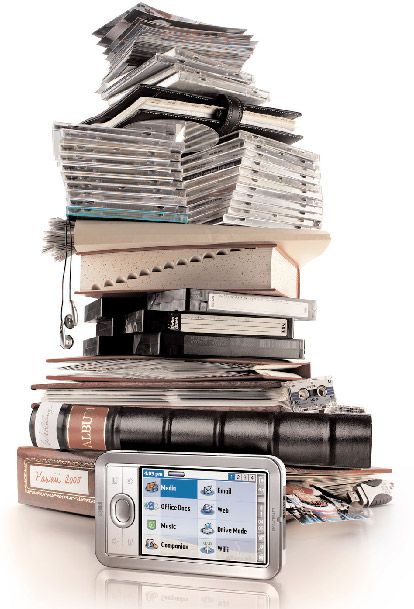
We see a mountain of audio disks, video cassettes, photos heaped and some albums, an address book, a reference book and a folder with documents. If we have a closer look, we see player headphones, several voice recorder cassettes and a small USB-drive to the right. In the foreground there is a small device called the LifeDrive, which can store all this things. The multimedia orientation is obvious taking into account the built-in HDD.
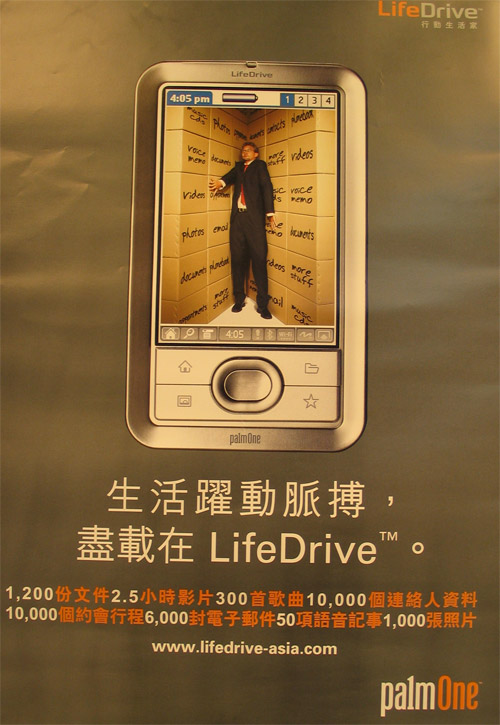
Let's have a look at another advertisement of the LifeDrive, the photo of which was taken in a shop of Taipei. We see a young man, who is shocked of large quantity of disarranged boxes. And naturally the LifeDrive comes to help. A passersby catches a thought: "what an interesting solution, why I haven't thought to buy a PDA before". But this is a matter of good marketing, so let's see how the things stand in reality.
Firstly, if we care about multimedia opportunities only (audio, video, photo), so specialized pocket media centers have long exceeded 20 GB HDD capacity, many new such models offer basic opportunities of the PDA, such as address book, calendar.
Secondly, the built-in HDD and a single expansion slot are the kind of a combination of a dual slot PDA and a 4 GB Compact Flash Hitachi Microdrive. The only difference is that you can't eject the disk replacing it with other card. There might be a price economy? The lowest current price for the LifeDrive in Russia is $450, in the US - $500. And the lowest price for Hitachi Microdrive 4 GB - about $200. We can actually spare something, depending on the price of an alternative PDA.

The fact that the device has a hard disk explains increased dimensions (compared to the Tungsten T5) and higher power consumption. The maker had to extend battery capacity, which increased dimensions and weight again (121x73x19 mm, 193 g). You can hardly call the device light and of average size. Such parameters are rather typical for Hi-End Pocket PC. The angular form the LifeDrive seems bigger that it is in fact. You won't carry the PDA on the neck lace, it's not comfortable to carry it in the pocket of the jeans. It fits the pocket of the jacket or the belt case, as well as in the field bag. I'd add, the LifeDrive turned to be smaller and nicer that depicted at photos. Shell materials represent the combination of metal and plastic, the assembly quality is at a high level.



Below the screen you see big buttons, which are very comfortable in use. That's also true for the joystick, it can be used in ordinary programs and in games as well. The basic assignment of the buttons isn't typical for Palm, i.e. the work with files, media data and the list of main applications. There aren't buttons to launch address book or calendar (though it's possible to reassign the buttons), organizer functions aren't in the forefront. In addition to the typical functions (charge level, missed alarms) the LED above the screen indicates the work of HDD, frequent glowing means HDD access.

There aren't any control elements at the right side. We find dipped Screen Rotate button (for the first time) and Voice Recorder button (there was no voice recorder even in Palm Tungsten T5) at the left side. The buttons are implemented well, you won't press them accidentally. I'd mark that the voice recorder makes high quality recordings.
The silo is located on the top end. The stylus is metallic and folding. Push it and it jumps up from the silo, its optimal size helps in use. Here you can also find an SD/MMC slot (SDIO supported) and an infrared window. There is an innovating thing - the slider serves as the power switch, slide it to opposite direction to block the device. This solution was implemented in PDA by Sony, it's the first time Palm applied it in its product.

The back panel is flooded with holes that hide the speaker. We found out that at the maximum sound volume the speaker is croaking, we didn't expect that effect from a multimedia oriented device.
At the bottom are a synchronization connector and a 3.5 mm headphones jack. The sound in the headphones is of high quality, so you can the PDA as the MP3 player.

Battery life
The Li-Ion battery is capacious of 1660 mAh, so we can expect long battery life. We ran our standard tests in 3 modes -maximum load (the highest backlight level, the playback of video via TCPMP), MP3 player mode (built-in application involved, the screen off) and book reading mode (iSilo program, auto page scrolling, the lowest backlight level). And we got the following results. To compare we chose dual slot Pocket PC, which can be alternative to the LifeDrive, and Palm Treo 650, an example of long battery life.

As we see, the hard disk affects the battery life of the PDA. 8 hours for MP3 playback can hardly be acceptable. HDD-MP3 players have the same results being fed by batteries of half capacity. Another flaw is that the battery is non-removable, so you can't replace it with a new or extended one. Well, when you make your buying choice, remember about these factors.
Battery charge LED shows behaves strangely, it can change sharply the level. For example, the battery is drained to 15%, but after the PDA lays still being switched off, the indicator shows 30%, after you start working the indicator falls sharply again.
Screen
The LifeDrive has one of the best screens among Palm devices, the specs are typical for top models of the company. We can compare this screen with those of the Tungsten T3 and T5, featuring a 320x480 (HVGA) resolution it is somewhere in the middle between QVGA and VGA screens for Pocket PC (picture quality, screen size). Its pluses are good color rendering and behavior under the sun, perfect viewing angles. The touch screen is soft and has good feedback. In all, this is on one the best screens for Palm, but it yields to VGA screens of top Pocket PC models.

Bluetooth and Wi-Fi
Bluetooth version is 1.1, Bluetooth opportunities are identical with the Tungsten T5. We won't go into details and just enumerate its possibilities. You can access the Internet via a Bluetooth-handset, dial numbers directly from contacts, send and receive SMS, synchronize data, receive files of known formats.
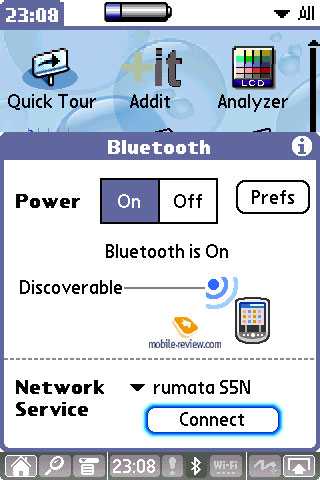
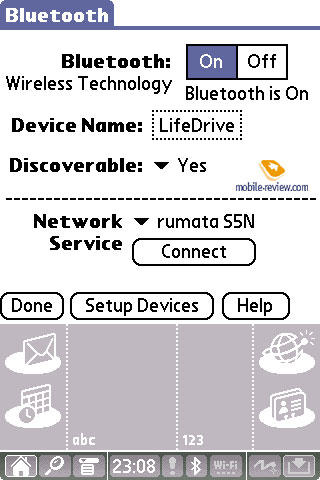
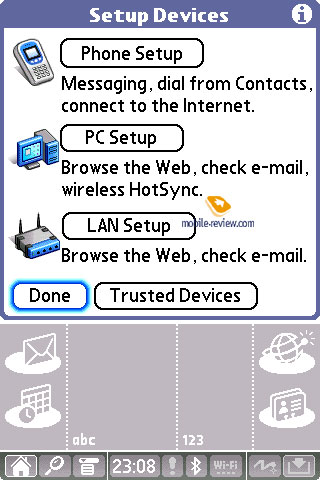
After non-successful corporate model Palm Tungsten C at last there appeared a Palm device with built-in Wi-Fi module. It's a common thing for Pocket PC, but not for Palm.
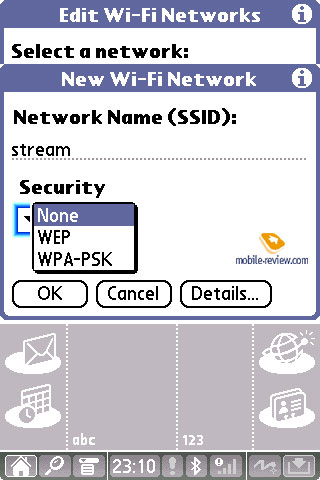
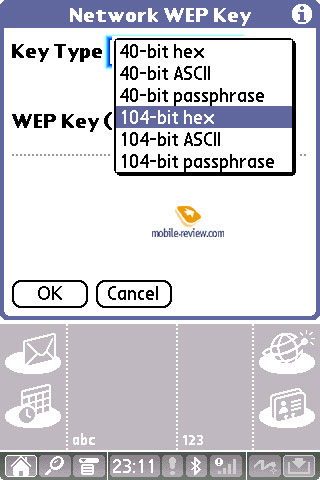
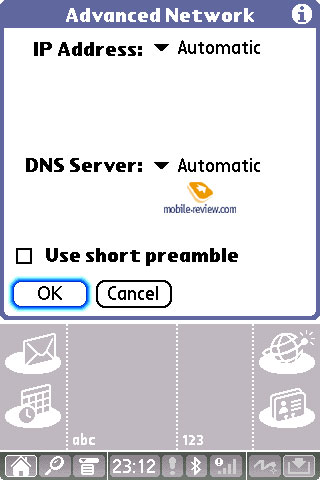
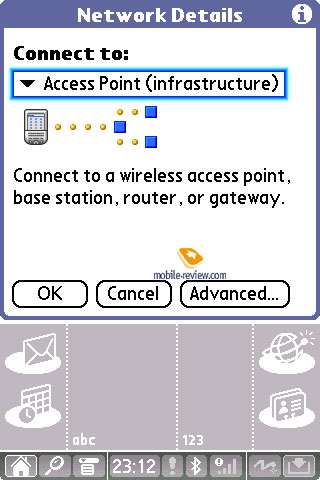

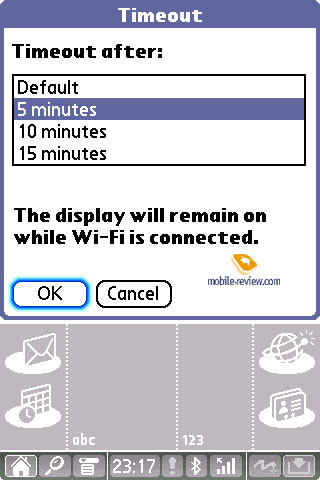
The adapter supports WPA encoding, it is switched off automatically if it is idle for several minutes (it's possible to adjust switch off time). Using Wi-Fi you can check your e-mail and browse Internet pages without problems and at high speed (however not simultaneously). You can view files via Wi-Fi using WiFile utility, which is included in the package. Single-task nature of Palm OS doesn't allow simultaneous work with several network applications, the fact restricts the use of Wi-Fi, but it's good for single usage.
Specifications, productivity
The LifeDrive has Intel XScale PXA270 416 processor inside, 32 MB of RAM is available. The operating system and applications are stored in closed HDD area. That is the reason for delays when you launch different applications, it can last for several seconds (HDD is probably wakes up). But once the application is in RAM, there won't be any delays. However it will be unusual for the users who are accustomed to instant work of Palm OS to see occasional slow downs.

After there appeared The
Core Pocket Media Player (former Beta Player) Palm OS users got the opportunity to view movies skipping conversion. In the next test we compare performance not only with Palm OS devices, but also with Pocket PC (BetaPlayer 0.5 launched on Pocket PC). Certainly, this comparison can't be fully correct, taking it into account you can't make final conclusion which PDA is faster the LifeDrive or the LOOX 710, for example. However the total results are good. It means for the final user the following - copy one or several DivX (or XviD) movies to HDD (initial file, you don't need to waste your time reconverting it) and watch them. The battery will last for one 2-hour movie (don't forget to set MicroDrive mode in player settings), but you'll hardly watch 2 movies. The movies run smoothly, only active scenes and frequent scene changes slow things down.
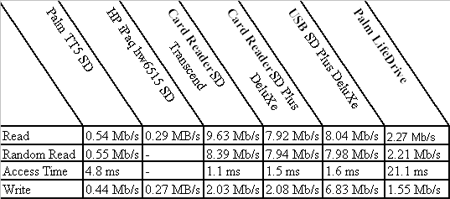
Write and read speeds are certainly of high importance. In the table you see the results of speed test. For the test we used Aida32 package. The results are acceptable, only access time fails, but this is an inevitable thing with HDD. I'd note a definite advantage against Palm Tungsten T5 in USB drive mode (like the T5 the LifeDrive can work in USB-drive mode, i.e. with almost any PC without drivers or HotSync application).

Let's see the results of synthetic tests, they are little informative, so we won't comment on them.
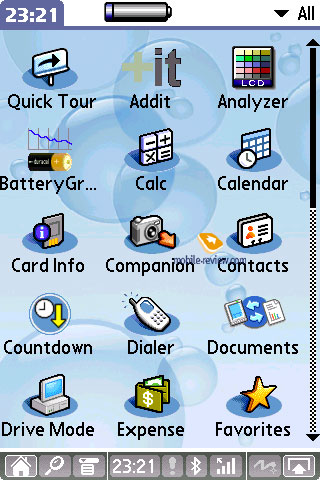
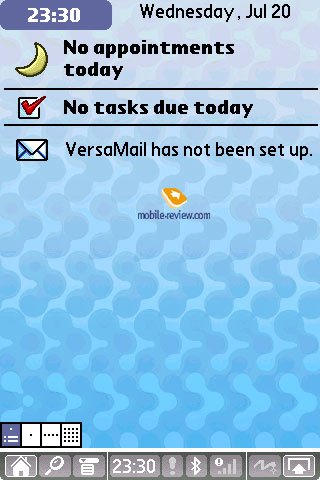
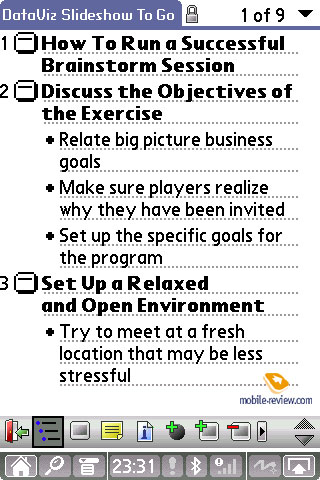
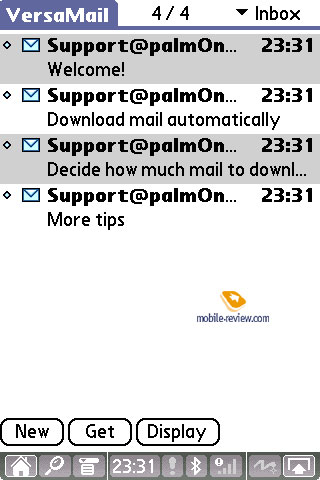
Software
The PDA is powered by Palm OS Garnet 5.4. All standard programs and their opportunities are the same as in Palm Tungsten T3 and T5, we'd write about some non-standard applications.
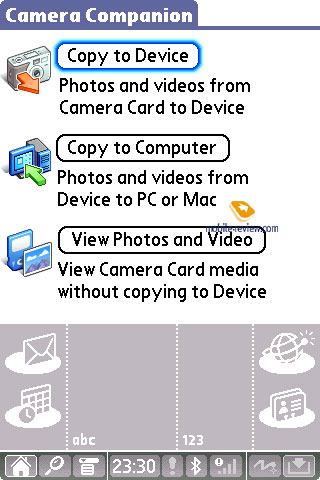
Camera Companion. This utility is meant to view pictures from the digital camera (only for cameras using SD cards), copy them to HDD LifeDrive, or from PDA to PC. You can just watch photos without copying them. Even big files are previewed at high speed.


Blazer. This Internet browser can stretch a page into a single column without horizontal scrolling.
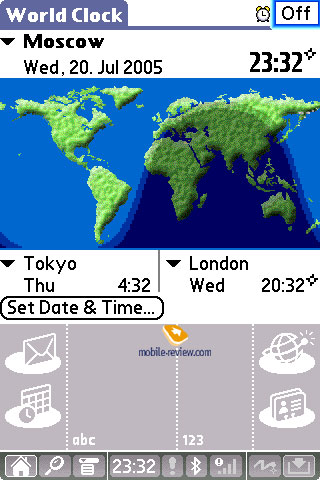
World Clock. It's a simple utility, which displays time in 3 selected cities.
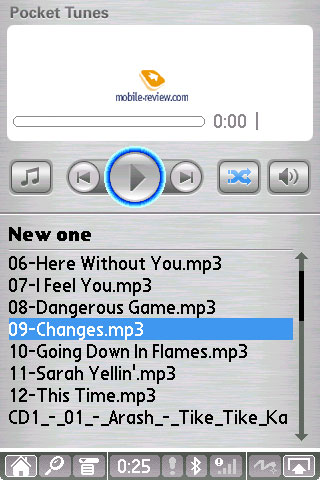
Pocket Tunes. This one of the best music players for Palm OS is already preinstalled.
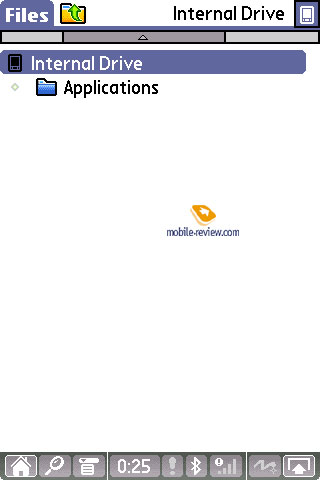
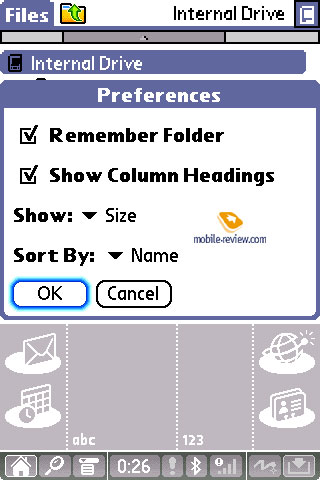
Files. This is a file manager. Palm made a logical step and added the file manager to the set of preinstalled programs.
Conclusions
The model produced ambiguous impression. The key innovation is the built-in HDD capacious of 4 GB and integrated Wi-Fi. There are other changes of less importance - better control, a voice recorder, extra programs in the sales package. However the HDD affected dimensions and weight, and decreased battery life.
With the price tag of $450 (the lowest retail price in Moscow) we can recommend this device as a cheap alternative to the pair "dual slot Pocket PC" + "4 GB Hitachi Microdrive". If you are an adherent to Palm OS and need Wi-Fi and large memory size onboard, you should pay attention to Palm LifeDrive, else we recommend Palm Tungsten T3 or T5.
Description:
- Class: PDA with built-in HDD
- Position in the line: opening
- Operating system: Palm OS Garnet 5.4
- Processor: Intel XScale 416 MHz
- RAM: 32 MB
- HDD: 4 GB (3.85 GB available to the user)
- Interface: SD/MMC supporting SDIO, IrDA, Bluetooth 1.1, Wi-Fi (802.11b), USB 2.0 for synchronization
- Screen: TFT 3.8" 480x320 pixels, 65K colors
- Battery: non-removable Li-Ion 1660 mAh
- Dimensions: 121x73x19 mm
- Weight: 193 g
Anton Kotov
([email protected])
Translated by Anja Rytchkova ([email protected])
Published - 8 August 2005
Have something to add?! Write us... [email protected]
|
News:
[ 31-07 16:21 ]Sir Jony Ive: Apple Isn't In It For The Money
[ 31-07 13:34 ]Video: Nokia Designer Interviews
[ 31-07 13:10 ]RIM To Layoff 3,000 More Employees
[ 30-07 20:59 ]Video: iPhone 5 Housing Shown Off
[ 30-07 19:12 ]Android Fortunes Decline In U.S.
[ 25-07 16:18 ]Why Apple Is Suing Samsung?
[ 25-07 15:53 ]A Few Choice Quotes About Apple ... By Samsung
[ 23-07 20:25 ]Russian iOS Hacker Calls It A Day
[ 23-07 17:40 ]Video: It's Still Not Out, But Galaxy Note 10.1 Gets An Ad
[ 19-07 19:10 ]Another Loss For Nokia: $1 Billion Down In Q2
[ 19-07 17:22 ]British Judge Orders Apple To Run Ads Saying Samsung Did Not Copy Them
[ 19-07 16:57 ]iPhone 5 To Feature Nano-SIM Cards
[ 18-07 14:20 ]What The iPad Could Have Looked Like ...
[ 18-07 13:25 ]App Store Hack Is Still Going Strong Despite Apple's Best Efforts
[ 13-07 12:34 ]Infographic: The (Hypothetical) Sale Of RIM
[ 13-07 11:10 ]Video: iPhone Hacker Makes In-App Purchases Free
[ 12-07 19:50 ]iPhone 5 Images Leak Again
[ 12-07 17:51 ]Android Takes 50%+ Of U.S. And Europe
[ 11-07 16:02 ]Apple Involved In 60% Of Patent Suits
[ 11-07 13:14 ]Video: Kindle Fire Gets A Jelly Bean
Subscribe
|


































